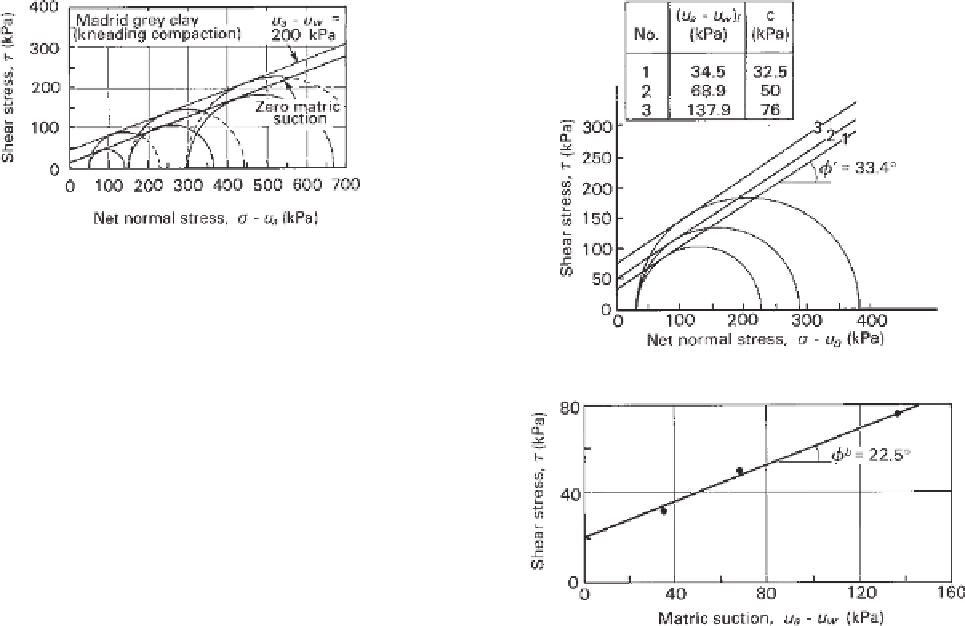Environmental Engineering Reference
In-Depth Information
Figure 11.24
Triaxial tests showing increase in shear strength
due to increase in matric suction for Madrid clay (modified from
Escario, 1980).
an increase in shear strength resulting from the increase in
matric suction.
A series of multistage triaxial tests was performed by
Ho and Fredlund (1982b) on unsaturated soils. Undisturbed
specimens of two residual soils from Hong Kong were used
in the testing program. The soils were decomposed rhyolite
and decomposed granite. The program consisted of consol-
idated drained tests with the pore-air pressure controlled
from the top of the specimen through a coarse porous disk.
The pore-water pressure was controlled from the bottom of
the specimen using a high-air-entry disk sealed around the
perimeter onto the base pedestal. The desired matric suction
in the specimen was obtained by controlling the pore-air and
pore-water pressures using the axis translation technique.
The triaxial test results showed that a single soil speci-
men could be used to provide an indication of the increase in
strength as a result of increasing matric suction. The assump-
tion was made that the effective angle of internal friction
φ
remained a constant value. Typical two-dimensional projec-
tions of the failure envelope onto the shear stress
τ
versus
σ
(a)
(b)
Figure 11.25
Two-dimensional presentation of the failure enve-
lope for decomposed granite specimen No. 22: (a) failure envelope
projected onto
τ
versus
σ
-
u
a
plane; (b) Intersection line between
failure envelope and
τ
versus
u
a
−
u
w
plane (from Ho and Fred-
lund, 1982b).
matric suction plane. The
φ
b
angle commences at a value
equal to
φ
(i.e., 25.5
◦
when measured under saturated con-
ditions) at low matric suctions. The
φ
b
angle decreased to a
final value of 7
◦
at high matric suctions.
There have been many more recent studies on a wide
range of soil types. In general, the results corroborate the
test results from earlier studies. At the same time the shear
strength studies have led to a more indepth understanding
of shear strength behavior of unsaturated soils. In particular,
a number of studies have focused on the critical state shear
strength behavior of unsaturated soils.
u
a
plane are presented in Fig. 11.25a. The intersections
between the failure envelope and the ordinate are plotted
in Fig. 11.25b. The shear strength at failure increased for a
constant net confining pressure, as shown by the
φ
b
−
angle
in Fig. 11.25b.
Gan (1986) conducted a multistage direct shear testing
program on an unsaturated glacial till. A modified direct
shear box allowed the control of the pore-air and pore-water
pressures during the test. The shear box was enclosed in an
air pressure chamber in order to control the pore-air pressure.
The pore-water pressure was controlled through the base
of the specimen using a high-air-entry disk. Consolidated
drained direct shear tests were performed with matric suction
being controlled during shear (i.e., axis translation tech-
nique). Applied matric suctions ranged from 0 to 500 kPa
while the net normal stress was maintained at approximately
72 kPa. Typical test results are presented in Fig. 11.18. The
shear stress was plotted with respect to matric suction (i.e.,
τ
versus
u
a
−
11.3.2 Incomplete Stress Variable Measurements
Numerous shear strength tests on unsaturated soils have been
conducted without the measurement of pore-air and pore-
water pressures at failure. Unfortunately, these results are
of limited value in terms of obtaining a better understanding
of the shear strength of an unsaturated soil. The extended
Mohr-Coulomb shear strength envelope for unsaturated soils
requires that three shear strength parameters be defined,
namely,
c
,
φ
, and a linear or nonlinear angle with respect
to matric suction,
φ
b
. These parameters can be measured
u
w
plane) for constant net normal stress at
failure,
σ
f
−
u
a
f
. The results showed that there was non-
linearity in the failure envelope on the shear stress versus










Search WWH ::

Custom Search